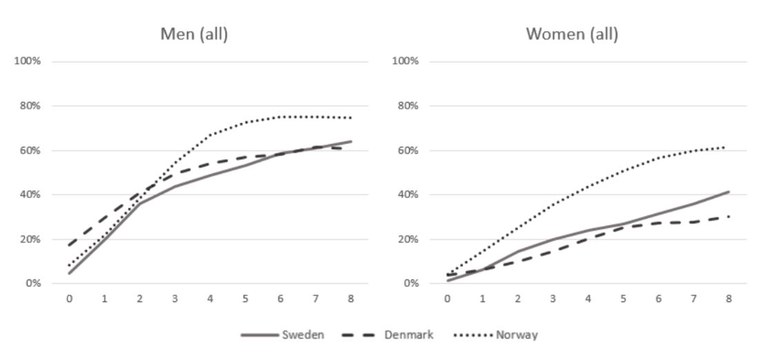Unique study compares how Denmark, Norway and Sweden integrate refugees
Who is best out of Denmark, Norway and Sweden at integrating refugees into their labour market? The answer depends at what stage after the refugees’ arrival you measure the success. Refugees to Denmark find jobs faster, but in the longer run more refugees get jobs in Sweden than in Denmark. Norway is the clear winner when it comes to integrating female refugees.
The four researchers behind a report on how Nordic countries integrate their refugees have performed a task which is both difficult and pretty unique; comparing how successful three countries have been when it comes to labour market refugee integration, and how this is linked to active policies.
“When I wrote my thesis on refugees, I noticed very few studies compare refugee policies across different countries,” says Vilde Hennes at the Department of Political Science in Norway.
The reason is the potentially wide range of variables. Vilde Hennes, Jacob Arendt from the Rockwool Foundation’s research unit, Pernilla Anderson Joona from Stockholm University and Kristian Tronstad from OsloMet have concentrated on three of the main differences.
Three hypotheses
Are the different results due to:
- Differences in age, education or gender among refugee groups arriving in the different countries
- Authorities’ integration measures?
- Refugee settlement regulation?
But first a word on the differences between the countries:
As the graph below shows, how well the countries manage to integrate their refugees differs. All three countries have less success integrating female refugees than male refugees. But Norway is a clear leader when it comes to integrating female refugees, both in the shorter and longer terms. The country is also better at integrating male refugees, but the differences between the countries are smaller in this category. Sweden surpassed Denmark towards the end of the eight year long period between 2008 and 2016.
 The graph shows Norway has the highest number of refugees who find work, except for the first two years for men, where Denmark is ahead. Sweden is lower down but does not remain low – its figures keep rising for longer than in the other countries.
The graph shows Norway has the highest number of refugees who find work, except for the first two years for men, where Denmark is ahead. Sweden is lower down but does not remain low – its figures keep rising for longer than in the other countries.
There are different groups of refugees arriving in the three countries. How does this impact the results?
“Sweden has more refugees above the age of 35. Norway has fewer married refugees compared to the other two countries. Norway also has the highest number of quota refugees and a larger proportion of refugees from Eritrea. The refugees’ origins change over time, however,” sums up Jacob Arendt.
Yet despite these differences, it is hard to identify each country’s level of success when it comes to their integration policies.
“The differences in the refugee groups explain the nearly seven percentage points in the employment gap between female refugees in Norway and Sweden. In other paired comparisons, the differences were no more than one to two percentage points,” says Jacob Arendt.
So how do the differences in measures play out? 92 to 96 % of the refugees are enrolled in language training, hence there are few differences there. There are, however, major differences in how many refugees are participating in internships – 73 % in Denmark and 23 % in Norway.
“It is difficult to calculate the figure for Sweden. 87 % take part in labour market programmes. Internships form part of that training, but it varies in size,” says Pernilla Anderson Joona.
Sweden spends the most on subsidised employment. This also increases people’s chances of finding regular work. But despite Sweden’s spending in this area, the other countries achieve better results.
Different rules for citizenship
The largest differences between Denmark, Norway and Sweden is found in refugee settlement regulations.
“To put it simply: in Denmark the state decides where refugees live for the first three years, in Norway municipalities get to decide and in Sweden the refugees themselves decide where they want to live,” says Kristian Tronstad.
As a result, more refugees in Sweden settle in cities – 72 %. The figure for Denmark and Norway is 50 %, but after the three years have passed, many of the refugees there move.
The level of local unemployment has little influence on people’s decision to move to urban areas.
Have the researchers managed to explain what is behind the differences in integration between the three countries? Yes, to a certain extent, but there are still differences that cannot be explained. One factor might be how much money is being spent on refugees.
“We have not looked at the impact this might have on integration,” says Kristian Tronstad.
What can the countries learn from each other?
In their conclusion, the researchers discuss what lessons the countries can learn from each other.
“There is not one single measure which would improve employment across all of the countries, because the refugee groups and policies differ so much. There are many different measures aimed at different parts of the refugee population,” write the four researchers.
A closer look at the statistics will for instance reveal that Denmark has had most success with men between 20 and 25, Norway is best with those aged 26 to 45 while Sweden has the most success with people between 46 and 55.
- Four researchers
-
from three countries (left to right): Kristian Tronstad, the Norwegian Institute for Urban and Regional Research (NIBR) at OsloMet; Vilde Hernes, University of Oslo, Pernilla Anderson Joona, Stockholm University and Jacob Arendt from the Rockwool Foundation’s research unit.
The report was commissioned by the Labour Market Committee of the Nordic Council of Ministers, and the full name is Nordic Integration Programmes for refugees– a Comparative Analysis of Labour Market Integration Outcomes.
- Theme content
-
 Follow us on Facebook
Follow us on Facebook
